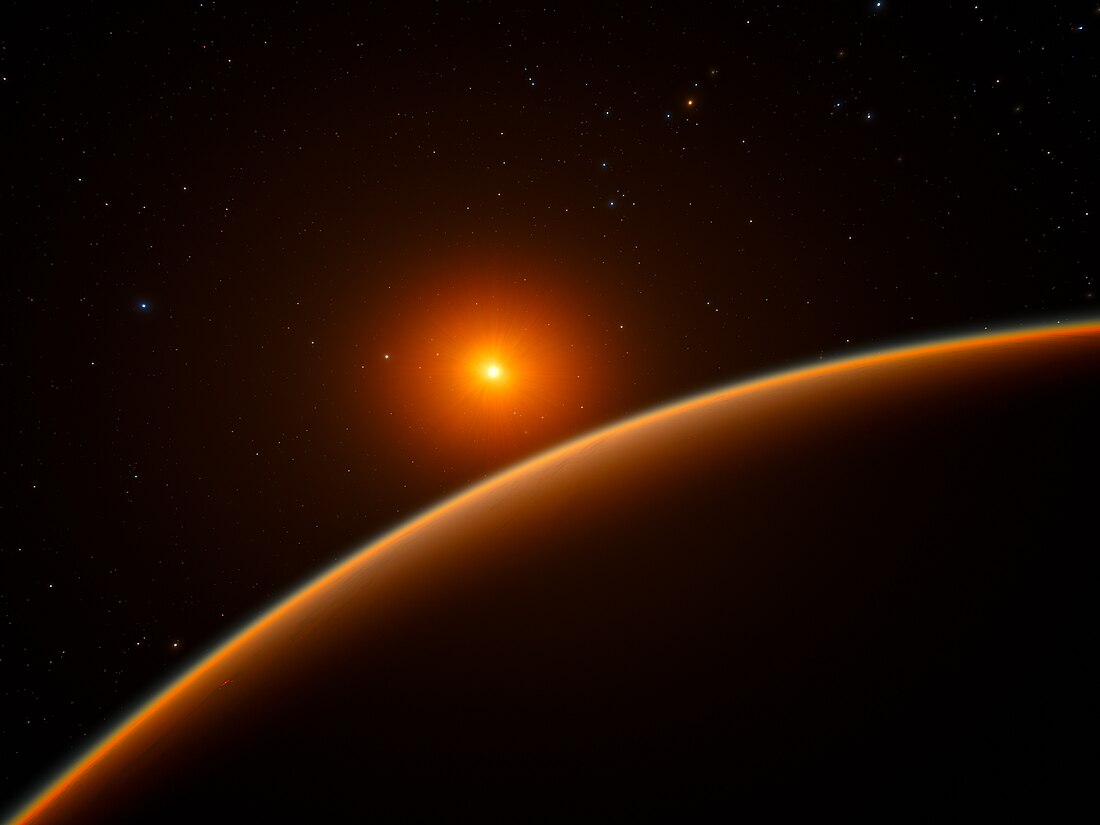LHS 1140
Star in the constellation Cetus From Wikipedia, the free encyclopedia
LHS 1140 is a red dwarf in the constellation of Cetus. Based on stellar parallax measurement, it is 48.8 light-years (15.0 parsecs) away from the Sun.[1] 'LHS' refers to the Luyten Half-Second Catalogue of stars with proper motions exceeding half a second of arc annually.[5] The star is over 5 billion years old and has only about 18% the mass of the Sun and 21% of its radius.[6] LHS 1140's rotational period is 130 days. No flares have been observed.[7]
| Observation data Epoch J2000.0 Equinox J2000.0 | |
|---|---|
| Constellation | Cetus |
| Right ascension | 00h 44m 59.33091s[1] |
| Declination | −15° 16′ 17.5428″[1] |
| Apparent magnitude (V) | 14.18[2] |
| Characteristics | |
| Evolutionary stage | Red dwarf |
| Spectral type | M4.5V[2] |
| Astrometry | |
| Radial velocity (Rv) | −13.74±0.42[1] km/s |
| Proper motion (μ) | RA: 318.152 mas/yr[1] Dec.: −596.623 mas/yr[1] |
| Parallax (π) | 66.8287±0.0479 mas[1] |
| Distance | 48.80 ± 0.03 ly (14.96 ± 0.01 pc) |
| Details[3] | |
| Mass | 0.1844±0.0045 M☉ |
| Radius | 0.2159±0.0030 R☉ |
| Luminosity | 0.0038±0.0003 L☉ |
| Surface gravity (log g) | 5.041±0.016 cgs |
| Temperature | 3,096±48 K |
| Metallicity [Fe/H] | −0.15±0.09 dex |
| Rotation | 131±5 d |
| Age | >5 Gyr |
| Other designations | |
| GJ 3053, G 270-58, G 268-38, LHS 1140, NLTT 2465, TOI-256, TIC 92226327, 2MASS J00445930-1516166[4] | |
| Database references | |
| SIMBAD | data |
| ARICNS | data |
Planetary system
Summarize
Perspective
As of October 2023, LHS 1140 is known to have two confirmed planets orbiting it.[3]
The first to be discovered was LHS 1140 b, discovered by the MEarth Project in 2017 using the transit method.[2] Follow-up radial velocities were measured by the High Accuracy Radial Velocity Planet Searcher instrument to confirm the planet and measure the mass.[7] The planet LHS 1140 b is a super-Earth in the habitable zone and transits the star every 24.7 days. This should allow its atmosphere to be studied in future: the combination of the transiting super-Earth and the relatively small and nearby host star make this system one of the most promising known for atmosphere studies, along with the TRAPPIST-1 system.[2][8] Observations by the Hubble Space Telescope in 2020 found signs of water vapor in the planet's atmosphere, but this has not been confirmed.[9]
LHS 1140 b was initially estimated to be about 7 times Earth's mass and about 1.4 times its radius, suggesting a dense rocky planet.[2] Later studies in 2018 and 2020 revised the radius upwards to about 1.7 times Earth's, giving it a density of about 7.5 g/cm3, still consistent with a rocky composition.[10][11] However, a 2023 study measuring the planet's mass and radius with greater precision found a lower mass of about 5.6 times Earth's, and a correspondingly lower density, no longer consistent with a rocky planet given the planet's size. LHS 1140 b is likely an ocean world (with 9-19% of its mass composed of water) or a dense mini-Neptune.[3]
In July 2018, Feng et al. published a reanalysis of the radial velocity data for LHS 1140, and proposed the likely existence of two additional planets: an inner Earth-mass planet orbiting every 3.8 days and an outer Neptune-mass planet orbiting every 90 days.[12] In August 2018, Ment et al., using the transit method of detection, confirmed the existence of the inner planet LHS 1140 c with a mass about 1.8 times Earth's and a radius 1.3 times as large, giving it a density of about 5 g/cm3,[10] consistent with a rocky composition.[3]
The orbital period of the outer planet candidate LHS 1140 d was refined to 78 days in 2020,[11] but this radial velocity signal was found to originate from stellar activity rather than a planet in 2023.[3]

| Companion (in order from star) |
Mass | Semimajor axis (AU) |
Orbital period (days) |
Eccentricity | Inclination | Radius |
|---|---|---|---|---|---|---|
| c | 1.91±0.06 M🜨 | 0.0270±0.0005 | 3.777940±0.000002 | <0.050 | 89.80+0.14 −0.19° |
1.272±0.026 R🜨 |
| b | 5.60±0.19 M🜨 | 0.0946±0.0017 | 24.73723±0.00002 | <0.043 | 89.86±0.04° | 1.730±0.025 R🜨 |
See also
References
Wikiwand - on
Seamless Wikipedia browsing. On steroids.

